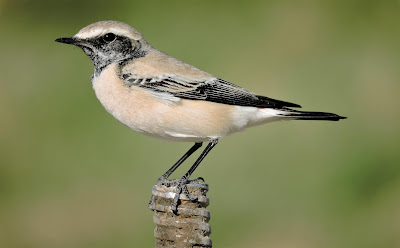I was alerted by Jens Eriksen on Tuesday that he had seen a streak-throated swallow at Raysut settling pools the day before. This was too good an opportunity to miss as this species is a vagrant to Oman.
Unfortunately for me, Tuesday afternoon proved to be extremely windy as part of a phenomenon affecting much of the Gulf.
There were hirundines in the air but none would settle to allow close inspection.
Rather than abandon birding altogether I walked round the site looking for any interesting grounded birds. I was successful in finding a very obliging Jack snipe.
Jack snipe
This was only the second one I have seen in Oman and certainly the better views. The other one had also been at the settling pools about one year before.
Jack snipe starting to lie low
It crouched down and allowed me to walk all the way round it from about three metres away.
frontal view of Jack snipe
I am pleased to say I left it behind in the end without flushing it.
final view of the jack snipe
Another notable bird on a very windy afternoon was a single blue-cheeked bee-eater. There are stragglers of this migratory species right through to mid-December.
blue-cheeked bee-eater
I was so keen to find the streak-throated swallow that I tried again on Wednesday afternoon. It was less windy but still not perfect. The Abdim's stork and White stork were still spending most of their time on the ground as flying conditions were still relatively poor.
grounded Abdim's stork
However I stuck to my task and headed straight to the dead bushes where hirundines seem to love to perch and waited. Unlike the day before the wind was light enough for them to land and many more of them were about as well.
young wire-tailed swallow
Barn swallow were coming and going. However it wasn't long before a wire-tailed swallow landed. This is a vagrant but not new one.
Streak-throated swallow (l) with barn swallow (r)
Ten minutes later, I was rewarded when the streak-throated swallow landed.
closer to the streak-throated swallow
It is so small compared with barn swallow. In fact it is only 11 cm long.
closer still to the streak-throated swallow
There have only been 6 previous records of the species in Oman and the last one was 9 years ago. it became species 310 on my Oman list.
desert wheatear
After this success I moved around the settling pools for some more general birding. All the time the wind was dying down. I walked past a desert wheatear to a muddy area which housed no fewer than four common snipe in close proximity to each other. If you look carefully in the picture below you can see three.
three common snipe and a wood sandpiper
The longer bills and the lack of scallops on the mantle are good clues that no pin-tailed snipe were among them.
common snipe
The long-staying vagrant spur-winged lapwing was nowhere to be seen but it spends much of its time on the other side of the perimeter fence these days as that area has become greener. There are three red-wattled lapwing it associates with but it associates much more closely with one leaving the other often two separated. This was the case on Wednesday when two red-wattled lapwing were seen but not the other two lapwings.
red-wattled lapwing
While walking around I was quickly aware that there were two shades of colour among the very many pale crag martin on site.
Unlike the other hirundines, pale crag martin don't settle on dead bushes. So all observations were of birds in the air.
pale crag martin flying
My first thought was that some European crag martin had appeared.
barn swallow (l) and pale crag martin (r)
However it soon became clear that some of the pale crag martin were very pale indeed and were probably of the lighter sub-species I used to see in the Riyadh area. I am assuming the powerful northerly winds had a part to play.
two pale crag martin
As a final move, I went outside the site to the eastern fringe where I had seen the Jack snipe the day before and where I was also on the look out for my nemesis bird which is little crake. Neither bird was seen.
However a clamorous reed warbler was.
clamorous reed warbler
The sub-species brunnescens is the most common throughout Oman and eastern Saudi Arabia. This is sometimes called Indian reed warbler. Nevertheless this one had the browner upper parts and rustier flanks of the nominate species.
clamorous reed warbler
It's rustic colours showed up well as the light faded.
I was back out birding again in the Raysut area on Friday. It was eventful once again. I will blog about this next.




















No comments:
Post a Comment